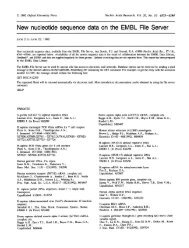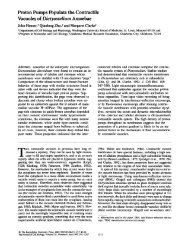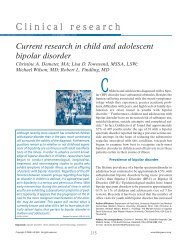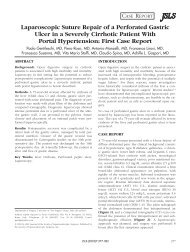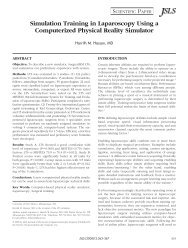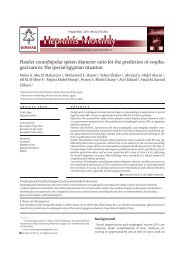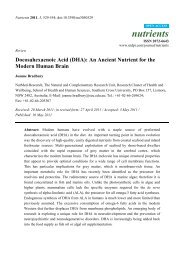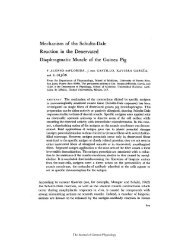Download PDF - BioMedSearch
Download PDF - BioMedSearch
Download PDF - BioMedSearch
Create successful ePaper yourself
Turn your PDF publications into a flip-book with our unique Google optimized e-Paper software.
Isolation of Yeast Mitochondria<br />
For the isolation of wildtype and Tim10 depleted mitochondria<br />
the Saccharomyces cerevisiae strains W303, PMET3Tim10 [87] were<br />
grown in synthetic glucose media [0.67% (w/v) yeast nitrogen, 2%<br />
(w/v) glucose, 0.01% (w/v) leucine, tryptophan, uracil, adenine<br />
and histidine at 30uC for 10 hours as a pre-culture. The preculture<br />
was diluted to A 600 nm = 0.2units/mL in media supplemented<br />
with 0.2 mM methionine then grown for 2 days to reach<br />
A 600 nm = 1.0 before harvesting and mitochondrial isolation by<br />
previously described methods [86].<br />
Synthesis of [ 35 S]-labeled LncP<br />
DNA encoding LncP was amplified and cloned into pSP73<br />
(Promega) from genomic DNA isolated Legionella pneumophila (strain<br />
130b). The oligonucleotides LncP-FW BamHI (GCGCGGATC-<br />
CATGAAAGACAAAACAATA), and LncP-REV XhoI (GATCC<br />
TCGAGCTACCTGTTCCTTGTTGG) were used to amplify<br />
full length LncP DNA In vitro transcription was carried out as<br />
previously described [88]. Rabbit reticulocyte lysate was purchased<br />
from Promega and in vitro translation reactions were carried<br />
out for 30–60 minutes in the presence of [ 35 S]- methionine/<br />
cysteine (MP Biomedicals) [88].<br />
In vitro Import Reactions<br />
[ 35 S]-Methionine/cysteine-labeled LncP or PiC were synthesized<br />
in vitro and were incubated with mitochondria (50 mg per lane) for<br />
the indicated time periods at 25uC in import buffer (0.6 M sorbitol,<br />
50 mM Hepes (pH 7.4), 2 mM KPi (pH 7.4), 25 mM KCl, 10 mM<br />
MgCl2, 0.5 mM EDTA, 1 mM dithiothreitol, 4 mM ATP, and<br />
2 mM NADH). Samples were treated with Proteinase K (40 mg/<br />
mL) in import buffer for 15 minutes on ice to remove un-imported<br />
material before addition of protease inhibitor (1 mM PMSF). The<br />
mitochondria were re-isolated by centrifugation at 10,000 g and this<br />
was followed by either protein separation under denaturing gel<br />
electrophoresis (SDS) or protein complexes separated by Blue<br />
Native electrophoresis [89]. For Proteinase K shaving or mitochondrial<br />
membrane potential dissipation conditions, mitochondria<br />
were treated with 40 mg/ml Proteinase K or AVO mix (8 mM<br />
antimycin A, 1 mM valinomycin, and 20 mM oligomycin) respectively.<br />
For preparation of mitoplasts (mitochondria with ruptured<br />
outer mitochondrial membrane), post-import mitochondria were<br />
subjected to osmotic shock by resuspension in 20 mM Hepes/<br />
KOH, pH 7.4 with and without Proteinase K where indicated.<br />
Sodium Carbonate Extractions<br />
After the completion of in vitro import reactions for 8 minutes at<br />
25uC, mitochondria were re-isolated by centrifugation at 10,000 g<br />
and resuspended in 200 mL of 100 mM sodium carbonate which<br />
was adjusted to pH 11.5 and left on ice for 30 minutes with gentle<br />
mixing every 5 to 10 minutes. A membrane pellet was then<br />
separated from a supernatant by ultra-centrifugation at 100,000g<br />
for 30 minutes at 4uC. The pellet was resuspended in 200 mL of<br />
100 mM sodium carbonate and both the pellet and supernatant<br />
were then subjected to Trichloroacetic acid precipitation. Each<br />
experiment was conducted in duplicate with one set of pellet and<br />
supernatant samples recombined to make the ‘‘total’’ sample. This<br />
was repeated 5 times in order to assess statistical significance. LncP<br />
protein level was quantified by densitometry of phosphorimages<br />
using the Image Quant software.<br />
Reconstitution of LncP into Liposomes and Transport<br />
Measurements<br />
Expression of recombinant LncP is detailed in the supporting<br />
methods (Protocol S1). The recombinant, purified LncP was<br />
A Mitochondrial Carrier Protein in Legionella<br />
reconstituted into liposomes by cyclic removal of the detergent<br />
with a hydrophobic column of Amberlite beads (Fluka) [61]. The<br />
composition of the initial mixture used for reconstitution was 35 ml<br />
of purified LncP (15 mg of protein), 70 ml of 10% Triton X-114,<br />
100 ml of 10% phospholipids in the form of sonicated liposomes,<br />
10 mM ATP (except where otherwise indicated), 10 mM PIPES<br />
(pH 7.0), 0.42 mg of the mitochondrial lipid cardiolipin (Sigma)<br />
and water to a final volume of 700 ml. After vortexing, this mixture<br />
was recycled 13 times through the Amberlite column (3.560.5 cm)<br />
pre-equilibrated with a buffer containing 10 mM PIPES pH 7.0.<br />
All steps were performed at 4uC, except for the passages through<br />
Amberlite, which were carried out at room temperature.<br />
External substrate was removed from proteoliposomes on<br />
Sephadex G-75 columns pre-equilibrated with 50 mM NaCl<br />
and 10 mM PIPES at pH 7.0 (buffer A) and 4uC. The eluted<br />
proteoliposomes were distributed in reaction vessels and used for<br />
transport measurements by the inhibitor-stop method [61].<br />
Transport at 25uC was started by adding [ 3 H]ATP (Perkin Elmer)<br />
or [ 3 H]GTP (American Radiolabeled Chemicals) to proteoliposomes<br />
and terminated by addition of 20 mM pyridoxal-59phosphate<br />
and 20 mM bathophenanthroline. In controls, the<br />
inhibitors were added at the beginning together with the<br />
radioactive substrate. Finally, the external radioactivity was<br />
removed from each sample of proteoliposomes by a Sephadex<br />
G-75 column; the proteoliposomes were eluted with buffer A and<br />
their radioactivity was measured. The experimental values were<br />
corrected by subtracting control values. The initial transport rate<br />
was calculated from the radioactivity taken up by proteoliposomes<br />
after 2 min (in the initial linear range of substrate uptake). For<br />
efflux measurements, proteoliposomes containing 2 mM ATP or<br />
GTP were labeled with 10 mM [ 3 H]ATP or [ 3 H]GTP, respectively,<br />
by carrier-mediated exchange equilibration [61]. After<br />
50 min, the external radioactivity was removed by passing the<br />
proteoliposomes through Sephadex G-75 pre-equilibrated with<br />
buffer A. Efflux was started by adding unlabeled external substrate<br />
or buffer A alone to aliquots of proteoliposomes and terminated by<br />
adding the inhibitors indicated above.<br />
Disruption of LncP in L. pneumophila 130b<br />
An insertional mutation in LncP was created via homologous<br />
recombination. A ,1 kb fragment encompassing LncP was<br />
amplified by PCR from L. pneumophila 130b genomic DNA using<br />
the oligonucleotide primers, 59- caacggatcctatttcatttgtagtcccttg -39<br />
and 59- tcctgtcgacctgaaatattttcatggaaac -39. The resulting product<br />
was cloned into the BamHI and SalI sites of pPCRScript and a<br />
kanamycin resistance gene from Tn5 was introduced into the<br />
native PstI site of LncP. The construct was introduced into L.<br />
pneumophila 130b via natural transformation, as described previously<br />
[90]. Kanamycin resistant clones were assessed by PCR<br />
analysis and ampicillin sensitivity to detect replacement of lncP<br />
with lncP::km and the loss of pCR-Script. Two independent L.<br />
pneumophila lncP::km clones, LncP-3 and LncP-4, were chosen for<br />
further analysis in host cell replication assays.<br />
Macrophage and HeLa Cell Infection and Anti-HA<br />
Immunofluorescence<br />
The human monocytic cell line, THP-1 was maintained in<br />
RPMI 1640 supplemented with 10% fetal bovine serum in 5%<br />
CO2 at 37uC. The cells were prepared for infection with<br />
stationary-phase L. pneumophila as previously described [91].<br />
THP-1 cells were infected at a multiplicity of infection (MOI) of<br />
5 cells for 2 h in 5% CO2 at 37uC. Cells were then treated with<br />
100 mg/ml gentamicin for 1 h to kill extracellular bacteria and<br />
washed with PBS before being lysed with 0.01% digitonin.<br />
PLoS Pathogens | www.plospathogens.org 10 January 2012 | Volume 8 | Issue 1 | e1002459



